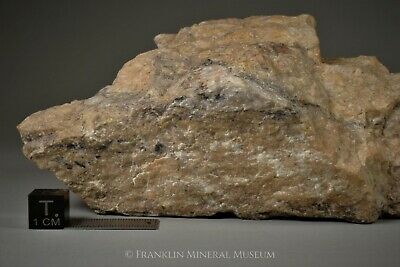-40%
Willemite micro breccia - Sterling Hill, Ogdensburg, NJ
$ 39.6
- Description
- Size Guide
Description
A neat example of geology in action! A fine example of massive, pink calcite with top and bottom surfaces exhibiting faint signs of slickensides. This piece is a remnant of a fault zone, which forms by tectonic movement along a fault zone in a rock. The grinding and milling result when the two sides of the fault zone move along each other, resulting in a material made of loose fragments. This fault movement has resulted in a fault breccia being formed. This would have been an oriented specimen. Many analytical techniques require oriented specimens. Structural sedimentologists, metamorphic geologists, engineering geologists, geophysicists, and ore geologists all use oriented specimens. The orientation of a mineral specimen is a fundamental data requirement and is the means by which their field orientation can be unambiguously reconstructed after collection. There is a subtle daylight contrast between the top portion of the specimen and the bottom part.The top portion is massive, pink-orange, dull-lustered calcite, and the bottom part is pink-tan, dull-lustered willemite. The contrast between the top and bottom portions becomes more pronounced when viewed under shortwave (254nm) ultraviolet light. The calcite fragments or clasts fluoresce a bright red, and the willemite clasts fluoresce a bright green. There are thin wispy veinlets of willemite working through the calcite portion. The willemite fragments are quite small; thus, this type of breccia is called a micro breccia. There is a fairly persistent (~20 seconds) phosphorescence for the willemite. This is a neat example of zinc ore taken up within a fault zone.
Dimensions are
21x8x5.7cm - 8¼x3¼x2¼in.
Please note the centimeter cube and inch bar for scale.
Weight in grams and ounces:
1009.1g - 35.59oz.
From the
Sterling mine, Ogdensburg, NJ.
The previous collection this specimen was in is
#114, Earl Verbeek.
#114 is the museum's Collection Sale number previously offered in the museum shop.
>>> We do
COMBINED SHIPPING
for multiple items. To
request
an invoice from us that combines shipping
ALWAYS
, click the
Add to cart
button on eBay to add items until you are done.
DO NOT PROCEED
to checkout; instead, click the
Request Total from Seller
button. <<<
=== There is an instructional video on how to request combined shipping is here
https://www.youtube.com/watch?v=FvDe7Fg7R4Q
===
All potential buyers need to be aware that being able to view fluorescent minerals requires an ultraviolet lamp. Most of the minerals from the Franklin and Sterling Hill zinc mining district fluoresce under
shortwave ultraviolet light
.
The shortwave wavelength is
254nm
or otherwise known as
UV C
. Always read the description carefully to determine if the main mineral of interest for a particular specimen will fluoresce.
ALL
fluorescent minerals depicted in our storefront are illuminated by two (2) 9 watt Triple short/mid/longwave AC Model 9SM-110 Way Too Cool LLC ultraviolet lamps, and the shortwave tubes and filters were replaced in late 2018.
There are several available brands and models of ultraviolet lights on eBay and other online sources. For further information on ultraviolet light and fluorescent minerals, copy and paste the following and go to >>>
geology.com/articles/fluorescent-minerals
.
>>>>
We Buy Collections
<<<<
DISCLAIMER: Every reasonable effort was made to identify the mineral species noted in each specimen accurately. The occasional label from previous collection(s) may misidentify some species, and the current title and description here reflect the latest mineral species identification.
A modest effort was made to depict a fluorescent specimen accurately as possible.
In some cases, overexposure should be expected in select photographs to compensate for a fluorescent specimen's weak response.
All buyers should exercise safe viewing practices regarding the use of ultraviolet light. Visual dark adaption is highly recommended in the optimal viewing of fluorescent minerals. Buyers should also be aware of what type of lighting to view the specimens under. This can result in perceived differences of color and contrast due to color and contrast shifting under various kinds of lights available.
All photographs were taken with a Nikon D5300 digital camera with a Nikon DX AF-S 18-55mm lens attached with a UV filter. Lighting was done with a pair of OSRAM 8.5 watt LED A19 5000K 800 lumens bulbs in brushed aluminum reflectors. The photographs were processed on a color-calibrated flat panel monitor. Do note the Imperial measurement conversion is the nearest equivalent to the listed metric measurement.
--- All photographs appearing on this listing or any other Franklin Mineral Museum listing are the property of the Franklin Mineral Museum. Photographs
can be used strictly for personal use onl
y
. Otherwise, the photographs posted here are protected by U.S. Copyright Laws. They are not to be downloaded or reproduced for public use or distribution in any way without the written permission of the Franklin Mineral Museum. ---
















